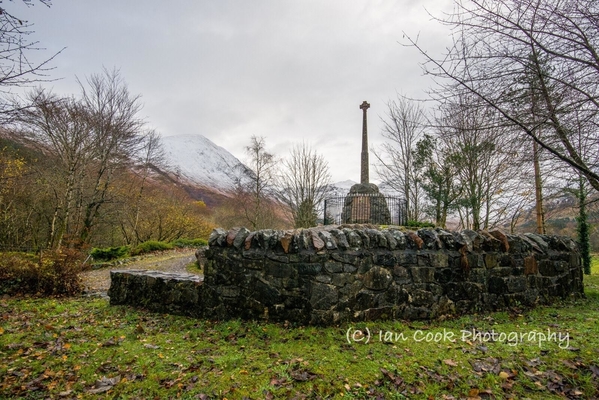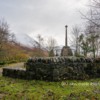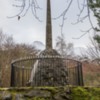Early on the morning of 13 February 1692, in the aftermath of the Jacobite uprising of 1689, an incident known as the Massacre of Glencoe (Mort Ghlinne Comhann in Gaelic) took place in Glen Coe in the Highlands of Scotland. Thirty-eight men from Clan MacDonald of Glencoe were killed by government forces billeted with them on the grounds they had not been prompt in pledging allegiance to the new monarchs, William III and Mary II. Another forty women and children later died of exposure after their homes were burned.
In March 1689, James II landed in Ireland with French assistance in an attempt to regain his throne. In support, John Graham, Viscount Dundee raised a force of Highlanders for a campaign in Scotland. Despite victory at Killiecrankie on 27th July, Dundee was killed and his troops suffered heavy casualties. Jacobite military resistance in Scotland ended with defeats at the Battle of Dunkeld in August 1689 and Cromdale in May 1690.
While unsuccessful, these were a major distraction for William III in fighting the Nine Years' War with France. A peaceful Scotland was important as links between Irish and Scottish branches of the MacDonalds as well as Scottish and Ulster Presbyterians meant unrest in one country often spilt into the other. Divisions between Lowlanders, Highlanders and internal factions within these groups made this a difficult task.
The Glencoe MacDonalds were one of three Lochaber clans with a reputation for lawlessness, the others being the MacGregors and the Keppoch MacDonalds. Levies from these clans were employed by Dundee in the Independent Companies used to suppress the Conventicles in 1678-80 and Argyll's rising in 1685. They combined in the devastating Atholl raid of 1685 and against their Maclean landlords in the 1688 battle of Maol Ruadh. All three were seen as a threat to stability by the outgoing Jacobite administration and that of William III.
After Killiecrankie, the Scottish Government held a series of negotiations with the Jacobites, terms varying based on events in Ireland and Scotland. In March 1690, Lord Stair, Secretary of State for Scotland offered the chiefs a total of £12,000 for swearing allegiance to William. They agreed to do so in the June 1691 Declaration of Achallader, with the Earl of Breadalbane signing for the government. The Battle of Aughrim in July ended any immediate prospects of a Stuart restoration.
A Royal Proclamation of 26th August 1691 offered a pardon to anyone taking the Oath prior to 1st January 1692, with severe reprisals for those who did not. Two days later secret articles added to the Declaration of Achallader were leaked, signed by all the attendees including Breadalbane; these voided the Declaration and promised James military support in the event of an invasion. The alleged source was Glengarry, the Jacobite chief of the MacDonalds; Breadalbane claimed they were a forgery but Stair's letters reflect his belief that forged or not, none of the chiefs would keep their word. Enforcement of the Oaths was now a key concern.
In early October, the chiefs asked James for permission to swear unless he could mount an invasion before the deadline, a condition they knew to be impossible. James sent his approval on 12th December, Glengarry received it on 23rd but did not share it until 28th. The suggestion is the delays were due to factional intrigue between the Episcopalian Jacobite majority and Glengarry, head of the minority Catholic element. The late receipt meant MacIain of Glencoe went to Fort William on 30th December to take the Oath from the governor, Lt Colonel John Hill. Since he was not authorised to accept it, Hill sent MacIain to Inverary with a letter for the local magistrate, Sir Colin Campbell. The letter confirmed MacIain's arrival before the deadline and asked Sir Colin to administer the Oath. This was done on 6th January and MacIain returned home.
On 2nd December, Stair wrote to Breadalbane ...the clan Donell must be rooted out and Lochiel. Leave the McLeans to Argyll... In January, he sent three letters in quick succession to Sir Thomas Livingston, military commander in Scotland; on 7th, he stated the intention was to ....destroy entirely the country of Lochaber, Locheal's lands, Kippochs, Glengarrie and Glenco... then on 9th January ...their chieftains all being papists, it is well the vengeance falls there; for my part, I regret the MacDonalds had not divided and...Kippoch and Glenco are safe. Finally on 11th January ...my lord Argile tells me Glenco hath not taken the oaths at which I rejoice....
These show the decision to make an example was taken in early December but planned as a much bigger operation including the 'papist' Glengarry, not simply the Episcopalian Glencoe MacDonalds. This explains the large number of troops (over 900) available for a relatively minor operation; MacIain's eldest son John MacDonald told the 1695 Commission Glenlyon's detachment came to Glencoe from the north '...Glengarry's house being reduced.' This refers to the demolition of Invergarry Castle; Glengarry took the Oath on 4 February with others doing so by proxy but only MacIain was excluded from the indemnity issued by the Scottish Privy Council. Glengarry had clearly reached an agreement with the government.
Motives varied. After two years of endless negotiations, Stair was under pressure to ensure the deal stuck; seeing targets like Glengarry and Lochiel disappear explains his relief Glencoe could not. Argyll was battling for political influence with his kinsman Breadalbane, who knew of the plan from Stair's letter but found it politically expedient to go along with it. He had also quarrelled with MacIain over damage done to his property and was concerned enough to send his steward on 15th February to offer MacIain's sons assistance in return for swearing he was not involved. Finally, the exact nature of Glengarry's role remains obscure but he features prominently throughout ie attending the Achallader meeting, alleged source for the leaked articles, instigator of the delays in obtaining and sharing James' approval etc. In summary, the Glencoe MacDonalds were a small clan with few friends, many enemies and an easy target.
In late January 1692, two companies or approximately 120 men from the Earl of Argyll's Regiment of Foot were billeted on the MacDonalds in Glencoe, ostensibly to collect property tax. Argyll's was a regular regiment raised in 1690 and based at Fort William; the commander of the two companies was Robert Campbell of Glenlyon, a hard-drinking 59 year old whose estates were nearby. Since the Highlands were largely a non-cash society, 'free quarter' was commonly used as payment in kind; the MacDonalds were initially suspicious but Glenlyon carried orders to that effect and it seemed routine.
Highland regiments were formed by first appointing Captains, each of whom was then responsible for recruiting sixty men from his own estates. The Argyll's muster rolls from October 1691 show the vast majority came from Argyllshire, including Cowal and Kintyre, areas settled by Lowlander migrants and badly hit by the raids of 1685 and 1686. This does not suggest the Massacre was related to a feud but the men involved were not outsiders.
Stair's letters to Lt-Colonel Hamilton and Colonel Hill of 30th January express concern the MacDonalds would escape if warned and the need to keep the plan secret. This correlates with evidence from James Campbell, one of Glenlyon's company, stating they had no knowledge of the plan until the morning of 13th February. Hill issued orders to Hamilton on 12th February, instructing him to take 400 men from Hill's regiment and block the northern exits from Glencoe at Kinlochleven. Another 400 men from Argyll's Regiment under Major Duncanson would join Glenlyon's detachment in the south and sweep northwards up the glen, killing anyone they found, removing property and burning houses.
On the evening of the 12th, Glenlyon received written orders from Duncanson carried by another Argyll officer, Captan Drummond. Glenlyon's niece was married to one of MacIain's sons and the tone shows doubts as to his ability or willingness to carry them out.
See that this be putt in execution without feud or favour, else you may expect to be dealt with as one not true to King nor Government, nor a man fitt to carry Commissione in the Kings service. Expecting you will not faill in the full-filling hereof, as you love your selfe...
John MacDonald, MacIain's eldest son told the Commission that Drummond detained his father for 24 hours at Barcaldine on his way from Fort William to Inverary on 30th December. It is possible Drummond was relied upon to ensure the orders were enforced; several witnesses gave evidence that he shot two people who asked Glenlyon for mercy.
The first to die was Duncan Rankin, shot down as he tried to escape by crossing the River Coe near the chief's house. Alasdair MacIain was shot twice and killed in his house but his sons escaped. In all, 38 men died either in their homes or as they tried to flee the glen, including nine who were first tied up and then shot; details of the killings were given to the Commission in 1695. Another 40 women and children died of exposure after their homes were burned.
Casualties would have been higher but whether by accident or design Hamilton and Duncanson only arrived after the killings. Duncanson joined Glenlyon at the southern end two hours late at 7:00 am, then advanced up the glen burning houses and removing livestock. Hamilton was not in position at Kinlochleven until 11:00; his detachment included two lieutenants, Francis Farquhar and Gilbert Kennedy who often appear in anecdotes claiming they 'broke their swords rather than carry out their orders.' This differs from the evidence they gave to the Commission in 1695 and in any case seems unlikely since they arrived hours after the killings which were carried out at the opposite end of the glen.
Shortly afterwards, Hamilton along with Duncanson and the Argylls were posted to Flanders where they fought in the Nine Years War until it ended in 1697 and the regiment disbanded. No further action was taken against Hamilton, Duncanson, Drummond or anyone else and Glenlyon died in Bruges in August 1696.
The killings first came to public attention when a copy of Glenlyon's orders allegedly 'left' in an Edinburgh coffee house was smuggled to France and published in the Paris Gazette of 12th April 1692. While it led to criticism of the Scottish government, there was little sympathy for the MacDonalds; Sir Thomas Livingston commented in a letter to the High Commissioner Lord Hamilton 'it's not that anyone thinks the thieving tribe did not deserve to be destroyed but that it should have been done by those quartered amongst them makes a great noise.' The primary driver was political; Stair had been a senior member of James II's Scottish administration and thus unpopular both with Jacobite loyalists and supporters of the the Williamite regime.
A Parliamentary Commission was set up in 1695, using the charge of 'Slaughter under trust,' a law introduced in 1587 in response to decades of feuding that followed the MacDonalds' loss of the Lordship of the Isles in 1493. The aim was to reduce internal conflict by forcing opponents to use legal arbitration and theoretically applied to murder committed after articles of surrender had been agreed or hospitality accepted. In reality, it was often used selectively; in 1597, James MacDonald's charge for locking his parents inside their house and setting fire to it while accompanied by 200 men was later judged 'hot-blooded' and excluded.
Since 'Slaughter under trust' was both a capital offence and treason, it was an awkward weapon with which to attack Stair, as William himself signed the orders and the intent was widely known in government circles. The Commission therefore focused on whether participants exceeded their orders, not the legality of them. Their conclusion was that Stair and Hamilton had a case to answer but left the decision to William. Stair was dismissed as Secretary of State but remained an influential politician, returned to government in 1700 and was later made an Earl by Queen Anne. An application by the surviving Glencoe MacDonalds for compensation was ignored and the Massacre faded into history until it re-appeared in the 19th century.
The question about Glencoe is why it remains so well known, since it was a savage but not unusual crime. For example, the MacDonald/MacLeod feud of 1577/78 allegedly started with the castration of a group of MacLeods for raping MacDonald women. The MacLeods responded by herding nearly 400 MacDonalds into a cave, then setting fire to it, ending with another mass murder at the Battle of the Spoiling Dyke. Breach of hospitality was less common but the very existence of the charge of 'Slaughter under trust' shows not unknown. The first prosecution in 1588 was of Lachlan Maclean, whose objections to his new stepfather John MacDonald led him to murder 18 members of the MacDonald wedding party in their sleep. The Glencoe MacDonalds themselves rebuilt their houses and participated in both the 1715 and 1745 Jacobite risings; as for many, the Highland Clearances were the real agent of their destruction.
The facts are complicated by the romanticisation of Highland culture that began in 1760 with James MacPherson's Ossian forgeries. It was later embedded in the widely-read novels of Sir Walter Scott and still appears in works like the 'Outlander' series. Victorian Scotland developed values that were pro-Union and pro-Empire while also claiming a unique Scottish cultural identity. Scottish history itself was seen as regressive and parochial and its study virtually disappeared from universities. It was replaced by '...the emotional trappings of the Scottish past...bonnie Scotland of the bens and glens and misty shieling, the Jacobites, Mary, Queen of Scots, tartan mania and the raising of historical statuary.'
The idea Glencoe was a particularly heinous crime came from Charles Leslie, a Non-Juring Irish Episcopalian priest who moved to London in 1690 and produced pro-Jacobite articles until his death in 1721. These included a virulent attack on William published in 1695 which focused on his alleged complicity in the 1672 death of Dutch Republican leader Johan de Witt but implied his connection to other crimes, one being Glencoe. The publicity led to the Parliamentary Commission that investigated the Massacre the same year.
The Massacre became more widely known when it appeared in the last volume of Macaulay's History, published posthumously in 1859. Macaulay's aim was to exonerate William of every charge, including Glencoe and is the origin of the claim it was caused by a Campbell-MacDonald feud. Victorian Scotland converted Glencoe into another symbol of the romantic past; this can be seen by comparing Peter Graham's 1889 painting 'After the Massacre' with Horatio McCulloch's 1864 work 'Glencoe, Argyllshire,' where it is simply part of the wild, rugged and empty Highland landscape.
Until the 1960s, Leslie's perspectives shaped views of William's reign as particularly disastrous for Scotland, with Glencoe part of a series of incidents like the Darien scheme, the famine of the late 1690s and ultimately Union in 1707. Modern Scottish Nationalism has dramatically changed approaches to Scottish historiography but the Massacre still functions as a symbol. The Scottish Republican Socialist Movement holds an annual event that portrays Glencoe as a colonialist action of the London government. Although the SRSM is a tiny group, sectarian divides within modern Scottish politics mean that view is not uncommon.
The Upper Carnoch memorial was designed by MacDonald of Aberdeen in 1883 and is a tapering Celtic cross on a cairn at the eastern end of Glencoe village, formerly known as Carnoch. Each year, on 13 February, the Clan Donald Society of Edinburgh arranges an annual wreath-laying ceremony at the memorial to the Massacre of Glencoe; this originated in 1930 when a Miss Mary Rankin, Taigh a’phuirt, Glencoe, decided that a wreath should be laid annually on the monument, a ceremony continued by her family and still conducted today when members of Clan Donald from around the world attend the ceremony, along with local people.
For a list of Ian Cook's photography and TravelGumbo contributions, please click on this link





Comments (1)